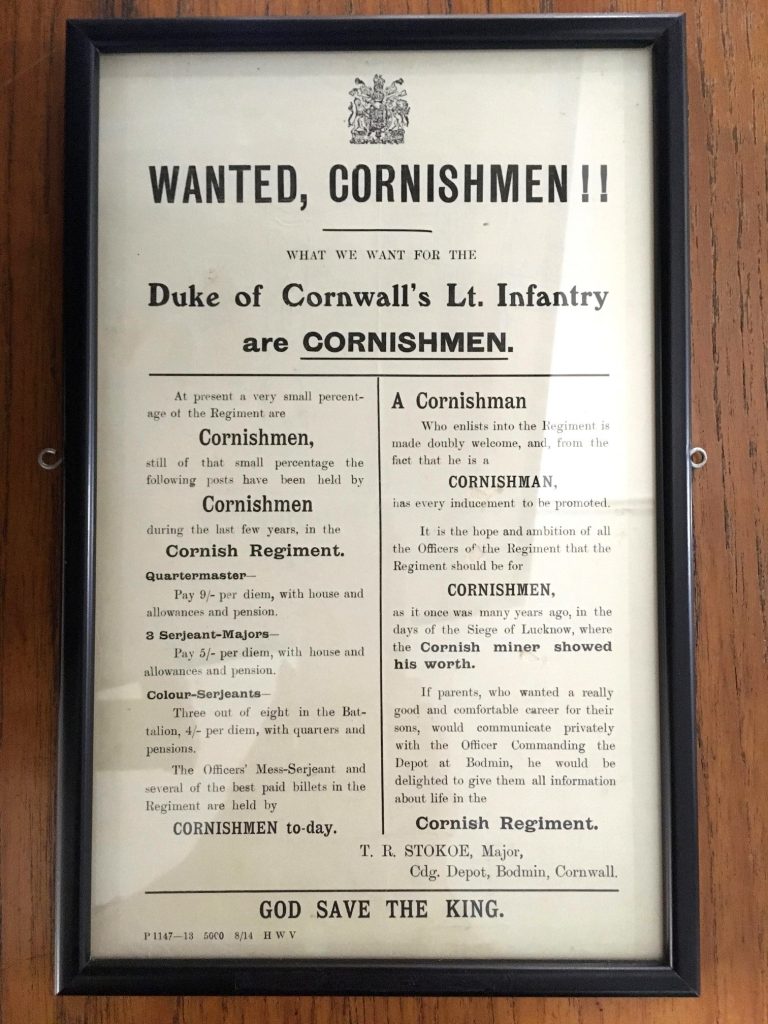DCLI Recruiting Leaflet, August 1914
This eye-catching leaflet, appealing for Cornishmen to join the Duke of Cornwall’s Light Infantry, is on display in the First World War gallery of the Museum. The leaflet was created in August 1914, at the start of the First World War, when three new battalions of the DCLI were formed. The leaflet gives details of the kind of roles available in the Regiment and their potential earnings: for example, a Quartermaster, who supervised stores and distributed supplies, could make 9 shillings a day (just under £20 in today’s money) with housing allowance and pension. The leaflet promises excellent career opportunities for Cornish men, who would be ‘made doubly welcome’ and would have ‘every inducement to be promoted’.
So great was the response, not only from Cornishmen but from all over Britain, that the Regimental Depot at Bodmin was totally overwhelmed by the number; the barracks which would usually have held no more than 200 men, suddenly found itself having to look after ten times that number without any additional resources. With remarkable efficiency, within days embryo ‘Kitchener’ battalions were set up across the South of England to which these volunteer recruits were dispatched. The 6th Battalion, commanded by Lieutenant Colonel T. R. Stokoe (mentioned in the leaflet) was established at Watts Common, near Aldershot.
It is astonishing with hindsight to think that parents who wanted “a really good and comfortable career for their sons” were asked to sign them up to the Army on the outbreak of war, even one which was expected to be over by Christmas. The leaflet asks parents to contact Major Stokoe, who at the time was the Officer commanding the Bodmin Depot. Major Stokoe soon became Lieutenant Colonel Stokoe DSO, commanding the newly formed 6/DCLI, which saw action less than a year after the leaflet was distributed. In 1915, 6/DCLI fought at Ypres, and were present during the explosion which formed the Hooge Crater. In the fierce battles which followed, Lt Col Stokoe was wounded by a trench mortar bomb, and 6/DCLI experienced one of the first uses of ‘Liquid Fire’, or Flammenwerfer (flamethrower). Nothing could have been further than the “good and comfortable career” they had been promised.

The DCLI barracks once included space for stores, cells and living quarters for hundreds of soldiers. Lieutenant Colonel Stokoe’s photograph still hangs in the DCLI Depot building today – on the second floor of the Museum which is housed in Bodmin Keep. Visitors can explore the Grade II listed Victorian Keep, and can see the recruiting leaflet in the First World War gallery, as well as the photograph of Major Stokoe in the ‘History of the Barracks’ exhibition.

The leaflet reads:
WANTED, CORNISHMEN!!
WHAT WE WANT FOR THE Duke of Cornwall’s Lt. Infantry
Are CORNISHMEN.
At present a very small percentage of the Regiment are Cornishmen
Still of that small percentage the following posts have been held by Cornishmen during the last few years, in the Cornish Regiment.
Quartermaster–
Pay 9/- per diem, with house and allowances and pension.
3 Serjeant-Majors-
Pay 5/- per diem, with house and allowances and pension.
Colour-Serjeants
Three out of eight in the Battalion, 4/- per diem, with quarters and pensions.
The Officers Mess-Serjeant and several of the best paid billets in the Regiment are held by CORNISHMEN to-day.
A Cornishman Who enlists in the Regiment is made doubly welcome, and, from the fact that he is a Cornishman, has every inducement to be promoted.
It is the hope and ambition of all the Officers of the Regiment that the Regiment should be for Cornishmen, as it once was many years ago, in the siege of Lucknow, where the Cornish miner showed his worth.
If parents, who wanted a really good and comfortable career for their sons, would communicate privately with the Officer Commanding the Depot at Bodmin, he would be delighted to give them all information about life in the Cornish Regiment.
- R. STOKOE, Major, Cdg. Depot, Bodmin, Cornwall.
GOD SAVE THE KING.
See our Object of the Month for July 2017, Steel Plate with Bullet hole here.

